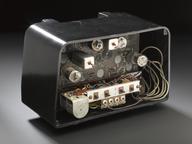

1:100 scale model of Marconi-Franklin uniform beam array
1:100 scale model of Marconi-Franklin uniform beam array aerial
1:100 scale model of a Marconi-Franklin uniform beam array, better known as a curtain array. Curtain arrays are a class of large multielement directional wire radio transmitting antennas, used in the shortwave radio bands.
Charles Samuel Franklin (1879-1964) was a senior engineer at the Marconi Company in Britain. In the early/mid 1920s, Franklin worked as an assistant for Guglielmo Marconi and the two worked together on the Marconi-Franklin beam as an aid to navigation of ships and for use with newly discovered short-wave radio system.
In the early 1920s, Guglielmo Marconi commissioned Franklin to carry out a large-scale study into the transmission characteristics of short wavelength waves and to determine their suitability for long distance transmissions. Franklin invented the first curtain array directional aerial system in 1924, known as the ‘Franklin’, ‘English’, FWBI or ‘Marconi-Franklin beam’ system.
The Marconi-Franklin array was one of the first high-speed short-wave point-to-point communication systems and consisted of a front curtain of vertical radiators, each consisting of several cophased dipoles in series, and another curtain of reflecting wires of the same construction situation one-quarter wavelength to the rear. There were twice as many reflectors as radiators.
This mechanically convenient, efficient and economic solution to aerial design contributed substantially to the development of short-wave radio communication.
The system was used for 'Imperial Beam System' introduced in 1927 and [as of 1964] there are still some of Franklin's FWBI transmitters in traffic.
Details
- Category:
- Radio Communication
- Object Number:
- 1982-1509
- type:
- model
- credit:
- British Telecom. Deptford Telephone Exch




